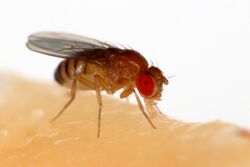Biology:Metchnikowin
| Metchnikowin | |
|---|---|
 The fruit fly, Drosophila melanogaster | |
| Identifiers | |
| Symbol | Metchnikowin, Mtk |
| InterPro | IPR012513 |
Metchnikowin is a 26-residue antimicrobial peptide of the fruit fly Drosophila melanogaster that displays both antibacterial and antifungal properties.[1] This peptide is expressed strongly in the Drosophila fat body (an organ similar to the human liver), but is also expressed at surface epithelia in the trachea and gut. This is regulated by the NF-κB signalling pathways Toll and Imd.[2] Metchnikowin is named after Russian immunologist Élie Metchnikoff, one of the founders of modern immunology.
Structure and function
Metchnikowin has microbicidal activity against the gram-negative bacterium Escherichia coli and filamentous fungus Neurospora crassa at nanomolar concentrations.[1] It is also one of the most abundant defence peptides in D. melanogaster following infection by the entomopathogenic fungus Beauveria bassiana.[3] Proline-rich peptides such as metchnikowin can bind to microbe ribosomes, preventing protein translation.[4]
References
- ↑ 1.0 1.1 "Metchnikowin, a novel immune-inducible proline-rich peptide from Drosophila with antibacterial and antifungal properties". European Journal of Biochemistry 233 (2): 694–700. October 1995. doi:10.1111/j.1432-1033.1995.694_2.x. PMID 7588819.
- ↑ "Two distinct pathways can control expression of the gene encoding the Drosophila antimicrobial peptide metchnikowin". Journal of Molecular Biology 278 (3): 515–27. May 1998. doi:10.1006/jmbi.1998.1705. PMID 9600835. http://infoscience.epfl.ch/record/151749.
- ↑ "Drosophila host defense: differential induction of antimicrobial peptide genes after infection by various classes of microorganisms". Proceedings of the National Academy of Sciences of the United States of America 94 (26): 14614–9. December 1997. doi:10.1073/pnas.94.26.14614. PMID 9405661. Bibcode: 1997PNAS...9414614L.
- ↑ "An antimicrobial peptide that inhibits translation by trapping release factors on the ribosome". Nature Structural & Molecular Biology 24 (9): 752–757. September 2017. doi:10.1038/nsmb.3439. PMID 28741611.
 |

